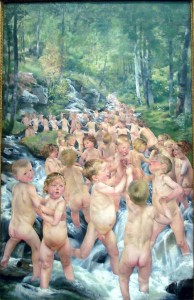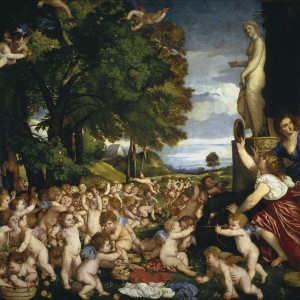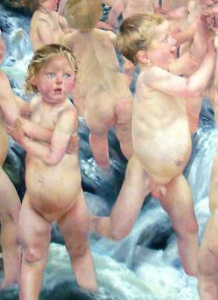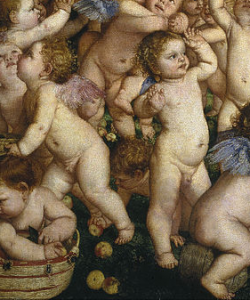The painting almost makes you want to look away, and you can see some visitors to the Philadelphia Museum of Art doing just that; others stare, giggle, or frown. A cascade of naked children pours down a mountain stream. At first you think they might be playing, but then you notice that none of them seems to be making eye contact, and that their staring eyes, most of which are blue, seem to be looking into some other world. That is Léon Frédéric’s “The Source of Life.” I’m not the only one to have found it a little disturbing.

Léon Frédéric, “The Source of Life”
Frédéric (1856–1940) was a Belgian Symbolist painter who studied at the Académie Royale des Beaux-Arts in Brussels and in Italy, where he learned to admire Renaissance painting. It’s not unreasonable to suspect that somewhere behind this odd painting lies a classical model—but what on earth could it be? Where could that carpet of creepy children come from?

Titian, “Offering to Venus”
One possibility is that at some point Frédéric encountered Titian’s “Offering to Venus.” In that painting, executed about 1518, Titian (ca. 1490–1576) showed Cupids or Erotes (the word just means “Loves”) reveling in front of their divine mother or patroness, the goddess Venus. There is the same receding procession of children, although these, being divine, have wings. The cupids play, but there is the same lack of eye contact. The naked children recede into the background, just as in Frédéric’s painting. In the foreground of Titian’s painting, one cupid turns away, left arm raised, as another, to his right, moves away. In the foreground of Frédéric’s painting, two children echo that movement.
There are, to be sure, some missing bits. Fréderéic’s painting lacks the dominating figure of Venus and her two worshipers, who enter Titian’s painting from stage left. But the resemblance is still there all the same. Frédéric may have imitated the Renaissance painter. But can we trace the image back even farther? is there a classical precedent?
 Titian certainly drew on the Imagines attributed to Lucius Flavius Philostratus (ca. 170–250). (The work may be by his son-in-law, also called Philostratus, but that possibility needn’t trouble us here.) The Imagines is an exercise in what ancient rhetoricians called ecphrasis, vivid description of a work of art. Imagines 1.6 describes a painting of Cupids or Erotes playing and gathering apples. A translation is here.
Titian certainly drew on the Imagines attributed to Lucius Flavius Philostratus (ca. 170–250). (The work may be by his son-in-law, also called Philostratus, but that possibility needn’t trouble us here.) The Imagines is an exercise in what ancient rhetoricians called ecphrasis, vivid description of a work of art. Imagines 1.6 describes a painting of Cupids or Erotes playing and gathering apples. A translation is here.
Most art historians would accept, I think, the link between Titian and Philostratus, but the link between Frédéric and Titian is harder to argue, at least for me. Probably because of my history-centered training in classical philology, I’d feel better if I could point to some evidence that Frédéric could have seen or known Titian’s painting, which is now at the Prado in Madrid. Many students of classical reception, though, do not feel the need of that kind of external evidence. For them, asking for proof of reception is the narrowest kind of historical positivism and turns the study of classical reception into an old-fashioned search for influences. When “may have known” is as close as we can get, it’s close enough, especially when the resemblances between a later work and its classical forebear are strong enough to be persuasive. Are they in this case?
